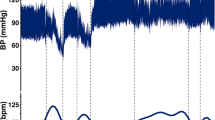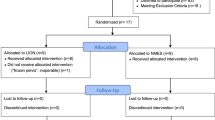Abstract
Study design
This work is a systematic review with meta-analysis
Objective
Evaluate the effect of electrical stimulation (ES) on skeletal muscle volume and spasticity in individuals with spinal cord injury (SCI).
Setting
University of Brasilia, Brazil
Methods
Searches were conducted of the Cochrane Library, MEDLINE, CINAHL, PEDro, PsycINFO and EMBASE electronic databases for relevant articles published up to June 2018. No restrictions were imposed regarding the year of publication. The inclusion criteria were randomized controlled trials involving adults with SCI comparing ES to an active or passive control. Two independent reviewers extracted the data from the selected studies and methodological quality was assessed using the PEDro scale.
Results
The initial search led to the retrieval of 164 studies, seven of which met the eligibility criteria, but only six were included in the meta-analysis. The six studies comprised 104 patients with complete or incomplete SCI. In the two studies that investigated the use of ES on muscle volume of the lower limbs, the overall effect was statistically significant in patients with acute SCI (mean difference: 0.86; 95% CI: 0.04 to 1.69; p < 0.04). Among the four studies that examined the use of ES for spasticity of the lower limb, the overall effect was non-significant (mean difference: 0.55; 95% CI: −0.31 to 1.41; p = 0.21).
Conclusions
Electrical stimulation was found to be an effective method for increasing muscle volume in SCI patients, but had no effect on spasticity. Further investigation of the effect of ES on spasticity in SCI is needed.
Similar content being viewed by others
Log in or create a free account to read this content
Gain free access to this article, as well as selected content from this journal and more on nature.com
or
References
Castro MJ, Apple DF Jr, Staron RS, Campos GE, Dudley GA. Influence of complete spinal cord injury on skeletal muscle within 6 mo of injury. J Appl Physiol. 1999;86:350–8.
Duckworth WC, et al. Glucose intolerance due to insulin resistance in patients with spinal cord injuries. Diabetes. 1980;29:906–10.
Bauman WA, Spungen AM. Disorders of carbohydrate and lipid metabolism in veterans with paraplegia or quadriplegia: a model of premature aging. Metabolism. 1994;43:749–56.
Nash MS. Exercise as a health-promoting activity following spinal cord injury. J Neurol Phys Ther. 2005;29:87–103.
Sheffler LR, Chae J. Neuromuscular electrical stimulation in neurorehabilitation. Muscle Nerve. 2007;35:562–90.
Doucet BM, Lam A, Griffin L. Neuromuscular electrical stimulation for skeletal muscle function. Yale J Biol Med. 2012;85:201–15.
Gorgey AS, Dolbow DR, Cifu DX, Gater DR. Neuromuscular electrical stimulation attenuates thigh skeletal muscles atrophy but not trunk muscles after spinal cord injury. J Electromyogr Kinesiol. 2013;23:977–84.
Needham-Shropshire BM, Broton JG, Cameron TL, Klose KJ. Improved motor function in tetraplegics following neuromuscular stimulation-assisted arm ergometry. J Spinal Cord Med. 1997;20:49–55.
Mazzoleni S, Stampacchia G, Gerini A, Tombini T, Carrozza MC. FES-cycling training in spinal cord injured patients. Conf Proc IEEE Eng Med Biol Soc. 2013;2013:5339–41.
McCaughey EJ, Borotkanics RJ, Gollee H, Folz RJ, McLachlan AJ. Abdominal functional electrical stimulation to improve respiratory function after spinal cord injury: a systematic review and meta-analysis. Spinal Cord. 2016;54:628–39.
Chang KV, et al. Effectiveness of bisphosphonate analogues and functional electrical stimulation on attenuating post- injury osteoporosis in spinal cord injury patients-a Systematic Review and Meta-Analysis. PLoS ONE. 2013;22:e81124. 8(11)
Oo WM. Efficacy of addition of transcutaneous electrical nerve stimulation to standardized physical therapy in subacute spinal spasticity: a randomized control trial. Arch Phys Med Rehabil. 2014;95:2013–20.
Duffell LD, Brown GL, Mirbagheri MM. Interventions to reduce spasticity and improve function in people with chronic incomplete spinal cord injury distinctions revealed by different analytical methods. Neurorehabil Neural Repair. 2015;29:566–76. (6)
Kapadia N, Masani K, Catharine Craven B, Giangregorio LM, Hitzig SL, Richards K, et al. A randomized trial of functional electrical stimulation for walking in incomplete spinal cord injury: effects on walking competency. J Spinal Cord Med. 2014;37:511–24.
Bohannon RW, Smith MB. Interrater reliability of a modified Ashworth scale of muscle spasticity. Phys Ther. 1987;67:206–7.
Walker JB. Modulation of spasticity: prolonged suppression of a spinal reflex by electrical stimulation. Science. 1982;9:203–4. 216(4542)
Han JS, Chen XH, Yuan Y, Yan SC. Transcutaneous electrical nerve stimulation for treatment of spinal spasticity. Chin Med J (Engl). 1994;107(1):6–11.
Seib TP, Price R, Reyes MR, Lehmann JF. The quantitative measurement of spasticity: effect of cutaneous electrical stimulation. Arch Phys Med Rehabil. 1994;75:746–50.
Crone C, Nielsen J, Petersen N, Ballegaard M, Hultborn H. Disynaptic reciprocal inhibition of ankle extensors in spastic patients. Brain. 1994;117:1161–68.
Perez MA, Field-Fote EC, Floeter MK. Patterned sensory stimulation induces plasticity in reciprocal Ia inhibition in humans. J Neurosci. 2003;23:2014–18.
Daly JJ, et al. Therapeutic neural effects of electrical stimulation. IEEE Trans Rehabil Eng. 1996;4:218–30.
Robinson CJ, Kett NA, Bolam JM. Spasticity in spinal cord injured patients: 1. Short-term effects of surface electrical stimulation. Arch Phys Med Rehabil. 1988;69:598–604.
Egger M, Smith GD, O'Rourke K. Rationale, potentials, and promise of systematic reviews. In: Egger M, Smith GD, Altman DG, editors. Systematic Reviews in health care: meta-analysis in context. London, UK: BMJ Publishing Group, 2011.
Higgins J, Green S. Cochrane handbook for systematic reviews of intervention. 2011. http://handbook-5-1.cochrane.org/front_page.htm. Accessed December 2018.
Siddiqui AM, Khazaei M, Fehlings MG. Translating mechanisms of neuroprotection, regeneration, and repair to treatment of spinal cord injury. Prog Brain Res. 2015;218:15–54.
Giangregorio L, et al. A randomized trial of functional electrical stimulation for walking in incomplete spinal cord injury: effects on body composition. J Spinal Cord Med. 2012;35:351–60.
Arija-Blázquez A, et al. Effects of electromyostimulation on muscle and bone in men with acute traumatic spinal cord injury: a randomized clinica trial. J Spinal Cord Med. 2014;37:299–309.
Baldi JC, Jackson RD, Moraille R, Mysiw WJ. Muscle atrophy is prevented in patients with acute spinal cord injury using functional electricalstimulation. Spinal Cord. 1998;36:463–9.
Ralston KE, et al. Functional electrical stimulation cycling has no clear effect on urine output, lower limb swelling, and spasticity in people with spinal cord injury: a randomized cross-over trial. J Physiother. 2013;59:237–43.
Aydin G, Tomruk S, Keleş I, Demir SO, Orkun S. Transcutaneous electrical nerve stimulation versus baclofen in spasticity: clinical and electrophysiologiccomparison. Am J Phys Med Rehabil. 2005;84:584–92.
Carty A, McCormack K, Coughlan GF, Crowe L, Caulfield B. Alterations in body composition and spasticity following subtetanic neuromuscular electrical stimulation training in spinal cord injury. J Rehabil Res Dev. 2013;50:193–202.
Bakkum AJ, et al. Effects of hybrid cycling versus handcycling on wheelchair-specific fitness and physical activity in people with long-term spinal cord injury: a 16-week randomized controlled trial. Spinal Cord. 2015;53:395–401.
Popovic MR, et al. Functional electrical stimulation therapy of voluntary grasping versus only conventional rehabilitation for patients with subacute incomplete tetraplegia: a randomized clinical trial. Neurorehabil Neural Repair. 2011;25:433–42.
Popovic MR, et al. Functional electrical therapy: retraining grasping in spinal cord injury. Spinal Cord. 2006;44:143–51.
Kapadia NM, et al. Functional electrical stimulation therapy for grasping in traumatic incomplete spinal cord injury: randomized control trial. Artif Organs. 2011;35:212–6.
Harvey LA, et al. Electrical stimulation plus progressive resistance training for leg strength in spinal cord injury: a randomized controlled trial. Spinal Cord. 2010;48:570–5.
Field-Fote EC. Combined use of body weight support, functional electric stimulation, and treadmill training to improve walking ability in individuals with chronic incomplete spinal cord injury. Arch Phys Med Rehabil. 2001;82:818–24.
GranatM KeatingJF, Smith AC, Delargy M, Andrews BJ. The use of functional electrical stimulation to assist gait in patients with incomplete spinal cord injury. Disabil Rehabil. 1992;14:93–7.
Bobet J. Can muscle models improve FES-assisted walking after spinal cord injury? J Electromyogr Kinesiol. 1998;8:125–32.
Gallien P, et al. Restoration of gait by functional electrical stimulation for spinal cord injured patients. Paraplegia. 1995;33:660–4.
Ping Ho Chung B, Kam Kwan, Cheng B. Immediate effect of transcutaneous electrical nerve stimulation on spasticity in patients with spinal cord injury. Clin Rehabil. 2010;24:202–10.
Goulet C, Arsenault AB, Bourbonnais D, Laramée MT, Lepage Y. Effects of transcutaneous electrical nerve stimulation on H-reflex and spinal spasticity. Scand J Rehabil Med. 1996;28:169–76.
Bajd T, Gregoric M, Vodovnik L, Benko H. Electrical stimulation in treating spasticity resulting from spinal cord injury. Arch Phys Med Rehabil. 1985;66:515–17.
Parziale JR, Akelman E, Herz DA. Spasticity: pathophysiology and management. Orthopedics. 1993;16:801–11.
Adams MM, Hicks AL. Spasticity after spinal cord injury. Rev Spinal Cord. 2005;43:577–86.
Funding
This study was funded by CAPES (88881.068134/2014–01).
Author Contributions
SRT was responsible for designing the review protocol, writing the protocol and report, conducting the search, screening potentially eligible studies, extracting and analyzing data, interpreting the results, updating reference lists and creating tables. LPC conducted the meta-regression analyses, was responsible for writing the protocol and report, extracting and analyzing data, interpreting the results, updating reference lists and creating summary tables. GCJ was responsible for designing the review protocol and screening potentially eligible studies. He contributed to writing the report, extracting and analyzing data and interpreting the results MFF contributed to data extraction and provided feedback on the report. EFM provided feedback on the report. GFBC contributed to the review of the manuscript and provided feedback on the report. WRM contributed to the review of the manuscript and the meta-analysis procedures.
Author information
Authors and Affiliations
Corresponding author
Ethics declarations
Conflict of interest
The authors declare that they have no conflict of interest.
Statement of ethics
We certify that all applicable institutional and governmental regulations concerning the ethical use of human volunteers were followed during the course of this research.
Additional information
Publisher’s note: Springer Nature remains neutral with regard to jurisdictional claims in published maps and institutional affiliations.
Rights and permissions
About this article
Cite this article
Thomaz, S.R., Cipriano Jr, G., Formiga, M.F. et al. Effect of electrical stimulation on muscle atrophy and spasticity in patients with spinal cord injury – a systematic review with meta-analysis. Spinal Cord 57, 258–266 (2019). https://doi.org/10.1038/s41393-019-0250-z
Received:
Revised:
Accepted:
Published:
Issue date:
DOI: https://doi.org/10.1038/s41393-019-0250-z
This article is cited by
-
Non-invasive cerebral and spinal cord stimulation for motor and gait recovery in incomplete spinal cord injury: systematic review and meta-analysis
Journal of NeuroEngineering and Rehabilitation (2025)
-
Impact of electrical muscle stimulation-induced muscle contractions on endogenous pain modulatory system: a quantitative sensory testing evaluation
BMC Musculoskeletal Disorders (2024)
-
Efficacy of aquatic therapy in people with spinal cord injury: a systematic review and meta-analysis
Spinal Cord (2023)
-
Effects of Bed Rest on Physical Performance in Athletes: A Systematic and Narrative Review
Sports Medicine (2023)
-
Identification of hub genes in the subacute spinal cord injury in rats
BMC Neuroscience (2022)



